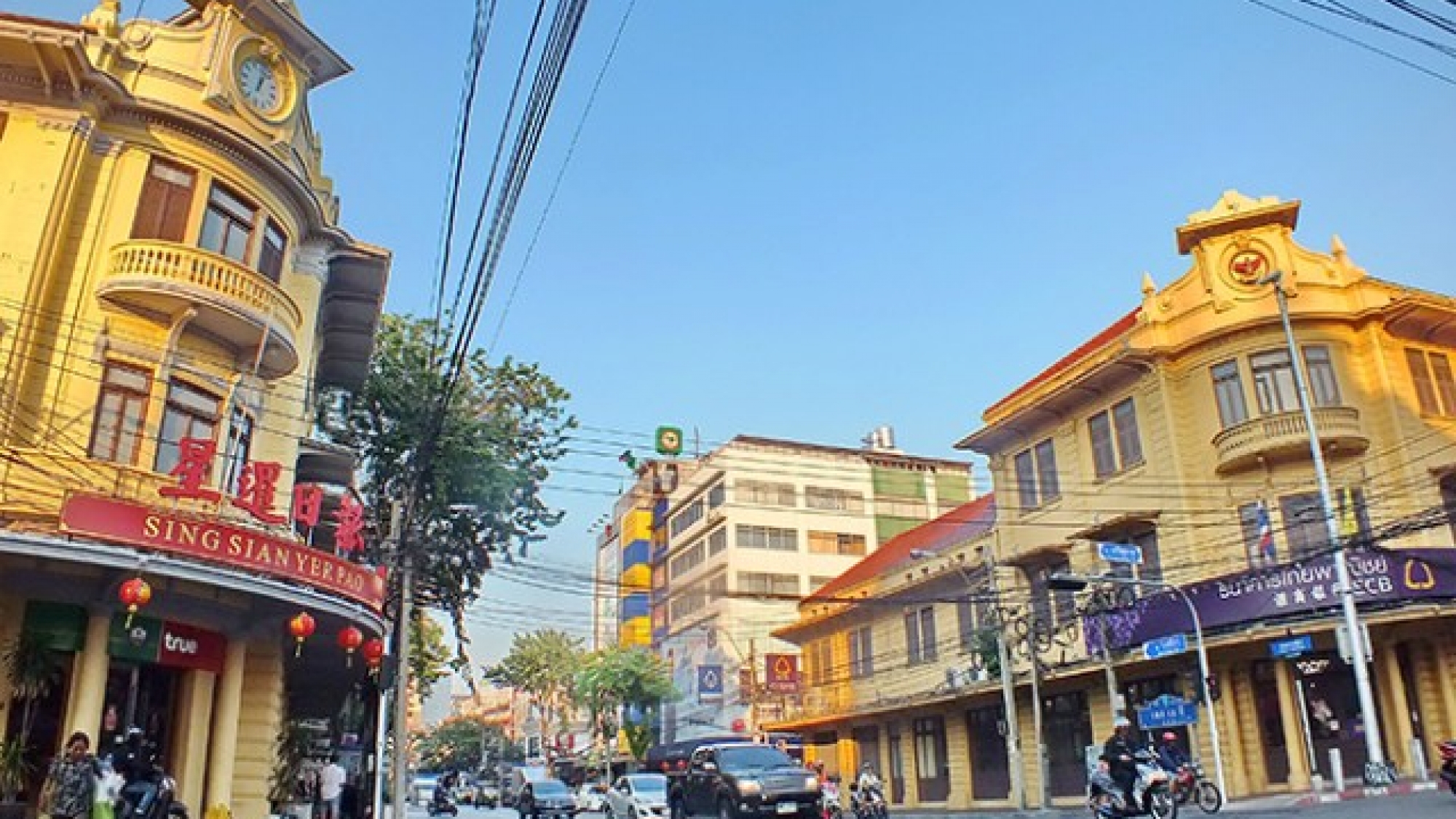When visitors think about Thailand’s architecture, images might come to mind of sleek stupas, mosaic-covered temples, dragon-ornate gables, or elegantly curved roofs and wooden houses. Eventually you will also think of the striking new skyscrapers, which step-by-step invade Bangkok’s skyline.
But few travellers think that Bangkok and Thailand would probably have one of the richest European architectural heritages in Southeast Asia. Many would even wonder how it could be possible in a country that was never colonised.

The history of European architectural influence in Thailand
If European colonization in the region stopped at the borders of Siam, Europe’s cultural influence extended far into the kingdom. King Rama IV (1804 -1868, ruled from 1851 until 1868), spoke fluent English and was very knowledgeable about European culture. Siam was pressured by the expanding colonial presence in Asia as treaties signed with the European powers opened Siam to foreign commerce for the first time. His rule was also characterized by the introduction of Western-style education as the King appointed Europeans in high government positions.

King Rama IV was a keen connoisseur of European architecture, and his reign marked the construction of the first Western-style buildings under royal patronage. Most symbolic was the Phra Nakhon Khiri Summer Palace in Phetchaburi province. Located on a hilltop, the Palace complex is a mix of Thai stupas and temples surrounded by European-style throne halls and residences with arcades, arches, renaissance-style windows and classical columns.
His son, King Rama V the Great (1853 -1910) continued the trend of European architecture. During his reign from 1868 to 1910, architects, engineers, sculptors and painters came from across Europe to contribute to Bangkok’s developing landscape around the Grand Palace and Chao Phraya River, which would replicate some of Europe’s most noted urban development. The idea of expanding European-style urbanisation and buildings – for a King who travelled twice to Europe in 1897 and 1907 – was to showcase the Kingdom of Siam as a modern country, equal to the neighbouring British, French and Dutch colonies. Bangkok was meant to be as splendid and modern as Hanoi, Singapore or Rangoon at the time.
European architecture in Siam was developed with the consent of the Chakri Dynasty- and not imposed by a colonial power- which allowed it to flourish in a multi-cultural context.
Its extreme diversity can trace its architectural influences from across Europe, mostly from Italy but also from Germany, Britain, Austria and France. When travelling around Bangkok today, it is easy to note the many buildings, bridges, street lights and even parks with eclectic styles: Italian Renaissance, Venetian Gothic, British Tudor, Indo-Saracenic (Indo-Islamic) style, French Classical, German Baroque or Art Nouveau.

European architectural heritage in Bangkok
Dusit and Phra Nakhon districts are the best areas to admire these types of European structures in Bangkok. Both feature a collection of Italian or German influences in palaces and buildings that blend European and Thai flourishes -the best examples are the Chakri Maha Prasat Throne Hall inside the Grand Palace and Wat Ratchabophit or Chulalongkorn University’s main hall. Even the famous Marble Temple (Wat Benchamabophit) with its very Thai-style architecture assimilates many Western design motifs. The layout was inspired by a church, the marble used is from Carrara while gothic stain-glassed windows bring light inside the Ubosot or main hall.
With the reign of King Rama VI, European architecture took a Siamese twist blending both styles. Vajiravudh College’s buildings are excellent examples of this evolving style. King Rama VI’s reign was also characterised by the achievement of many forms of infrastructure; such as, bridges or the beautiful Hua Lamphong Railway Station in Bangkok.
After the passing of King Rama VI, the European architectural influence declined until the Thai Revolution of 1932 with the transition to a Constitutional Monarchy. The new Thai government turned towards Europe again by following Art Deco and Monumental Rationalism architectural trends that were en vogue in Europe. Ratchadamnoen Klang Avenue and the surrounding area, which are lined by 1930s style buildings, with the majestic Democracy Monument as its centrepiece was heavily influenced by Italian architecture of that time.
While the greater Bangkok metropolitan area has probably the largest collection of European-style buildings in Thailand with over 200 structures still standing, Thai provinces are also well represented by European-style constructions due to various historical factors.


European architectural heritage in other Thai cities
The ongoing desire of various kings to build summer residences and palaces for their families resulted in magnificent European-style palaces. Around Bangkok, visitors can visit and enjoy excellent examples at the Bang Pa In Summer Residence in Phra Nakhon Si Ayutthaya province, the Sanam Chandra Palace in Nakhon Pathom, Phra Ram Ratchaniwet or the Ban Puen Palace and the Mrigadayavan Palace in Phetchaburi province, and Sri Racha Palace in Chon Buri province.
In the Northeast Region or Isan, the proximity of French Indochina along the Mekong River stimulated provincial governors to build mansions in a very classic French style. Such examples are well preserved and available in Nakhon Phanom, Nong Khai and Sakon Nakhon.
Along the Gulf of Thailand, provincial centres like Trat or Chanthaburi have many French-style buildings, due to some being under French administration for the better part of a decade.
In Thailand’s Northern Region, a wealth of teak wood resources brought merchants from the then British Burma. In Chiang Mai, Lampang or Phrae, many houses bear a distinctive British-Indian or Anglo-Burmese style.
In Thailand’s Southern Region, the influence of former British Malaya is evident. Chinese traders moved and worked in the tin industry along the Andaman Sea in towns like Phuket, Takua Pa, Trang or Songkhla where all exhibit architectural influences that are very similar to ones seen in Penang or Singapore and is best known as the ‘Peranakan style’, a mix of Chinese, Malay and British architecture.
Thailand will always be full of surprises for visitors through its architecture. Its rich history and cultural diversity, including European architectural excellence, remains unique in Southeast Asia.
Note to the editor
This is the first of the five-part story on European architectural heritage in Thailand written by Luc Citrinot. A French national, Luc is a busy freelance journalist and consultant in tourism and air transport with over 20 years’ experience. He has been the aviation editor for France’s leading business travel publication Voyages d’Affaires, since 1989. He is currently the Managing Editor for the online B2B publication ASEAN.travel. Luc relocated to Asia in 2003 to work as a Business Development Consultant for AirAsia and Thai AirAsia until 2005. Following his airline experience, he returned to journalism in tourism, air transport and increasingly in culture/architecture and heritage, commuting between Europe and Asia reporting extensively on Asian developments in both French and English around the world from his Asian base in Bangkok. In addition, he has recently been promoting European heritage architecture in Thailand with the support of the European Union.
Content : https://www.tatnews.org/europe-modernised-siams-architecture-guide-european-architectural-influence-thailand/


